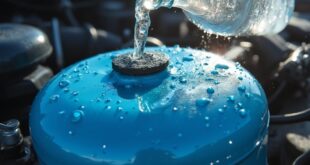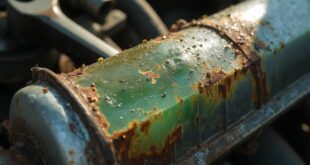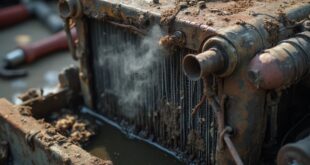If you notice coolant leaks from the thermostat housing, address them quickly to avoid engine damage. Start by inspecting the housing for cracks or damaged seals. You can temporarily seal minor leaks with tape or sealant, but a proper fix involves replacing the thermostat housing. Begin by draining the coolant, removing the old housing, cleaning the surface, and installing the new part. If you're unsure about any steps or need further guidance, there's more to explore.
Understanding the Role of the Thermostat Housing
Although you mightn't think about it often, the thermostat housing plays an important role in your vehicle's cooling system. It securely holds the thermostat, ensuring your engine maintains an ideal temperature.
By managing coolant circulation, it dictates when coolant stays in the engine and when it flows to the radiator. Typically located near the upper radiator hose, the housing may vary depending on your vehicle model. Some cars even have thermostats positioned on the lower hose.
Understanding its function helps you appreciate how crucial this component is in preventing overheating and maintaining your engine's performance.
Identifying the Causes of Coolant Leaks
When you're dealing with coolant leaks, it's essential to identify their causes quickly to prevent further damage to your engine.
Common culprits include a damaged or cracked thermostat housing, often seen in plastic parts. Failing seals or gaskets can wear down over time, leading to significant leaks.
Extreme temperatures may cause overheating, damaging the housing. Improper installation, like excessive torque, can crack the housing as well.
Finally, material fatigue, especially in plastic housings, can lead to leaks. By pinpointing these issues, you can address the problem before it escalates into a more serious engine concern.
Recognizing the Signs of a Failing Thermostat Housing
How can you tell if your thermostat housing is failing? Look for signs like coolant leaks around the housing or the engine overheating unexpectedly.
If your temperature gauge fluctuates or the heater's performance drops, that's a red flag too. Discolored or contaminated coolant might indicate a problem as well.
Pay close attention to any unusual smells or puddles under your vehicle. These symptoms suggest that your thermostat housing may be compromised, leading to potential engine damage.
Addressing these issues early can help you avoid more extensive repairs later on. Keep an eye out and act quickly!
Strategies for Managing Coolant Leaks
To effectively manage coolant leaks, you should first pinpoint the source of the problem. Inspect the thermostat housing, hoses, and clamps for any visible damage. If necessary, use dye or a UV light to trace the leak.
For temporary fixes, apply sealants or tape until you can implement a permanent solution. Regular preventive maintenance, like inspecting hoses and connections, can help catch issues early.
Keep an eye on your coolant levels and schedule routine cooling system flushes to maintain efficiency. Monitoring your vehicle's temperature gauge during drives can also alert you to potential problems before they escalate.
Steps for Thermostat Housing Replacement
Replacing the thermostat housing can be a straightforward process if you follow the right steps.
First, secure your vehicle on a flat surface and gather your tools. Let the engine cool completely, then drain the coolant into a bucket.
Next, remove the housing bolts with a socket wrench. Clean the surface to guarantee a good seal for the new housing.
Install the new thermostat housing, tightening the bolts firmly but not excessively. Refill the coolant to the proper level, then start the engine and check for leaks.
If everything looks good, you've successfully replaced the thermostat housing!
Related Components to Inspect During Repairs
While you're addressing the thermostat housing, it's crucial to inspect related components that could impact your vehicle's performance. Check these parts to verify everything runs smoothly:
| Component | Importance |
|---|---|
| DPFE Sensor | Affects engine performance |
| Starter Relay | Prevents starting issues |
| Fuel Pump Relay | Guarantees proper fuel delivery |
| Flywheel | Impacts engine start and operation |
| Sway Bar & Driveshaft | Contributes to vehicle stability |
Preventive Maintenance Tips for Longevity
Maintaining your vehicle's cooling system can prevent costly repairs and guarantee peak performance.
By staying proactive, you can extend the life of your thermostat housing and other components.
Here are some essential tips:
- Regularly check coolant levels to avoid leaks.
- Schedule routine cooling system flushes for maximum efficiency.
- Monitor your temperature gauge during drives for irregularities.
- Replace the thermostat every 50,000 to 100,000 miles as a precaution.
- Inspect hoses and connections for wear and tear regularly.
Frequently Asked Questions
How Can I Temporarily Stop a Coolant Leak Until Repairs?
To temporarily stop a coolant leak, you can apply a sealant or tape over the affected area. Make sure to keep the engine cool, and check fluid levels regularly until you can perform permanent repairs.
What Tools Do I Need for Thermostat Housing Replacement?
You'll need basic tools like a socket wrench, adjustable crescent wrench, screwdriver, and possibly pliers. Don't forget a coolant drain pan for catching fluid, along with a clean rag for any spills during replacement.
Can I Drive With a Leaking Thermostat Housing?
You shouldn't drive with a leaking thermostat housing. It can lead to engine overheating and further damage. Instead, address the leak promptly to guarantee your vehicle runs efficiently and avoid costly repairs later.
How Often Should I Check My Coolant Levels?
You should check your coolant levels regularly, ideally every month or before long trips. Keeping an eye on levels helps prevent overheating and guarantees your engine runs smoothly without unexpected issues or leaks.
Are There Specific Brands Recommended for Thermostat Housing Replacements?
When replacing thermostat housings, you should consider reputable brands like Gates, Stant, or ACDelco. They offer quality parts that guarantee reliable performance. Always check compatibility with your vehicle's make and model before purchasing.
 Car Service Land Coupons for Oil change, Tires, Wheel alignment, Brakes, Maintenance
Car Service Land Coupons for Oil change, Tires, Wheel alignment, Brakes, Maintenance




